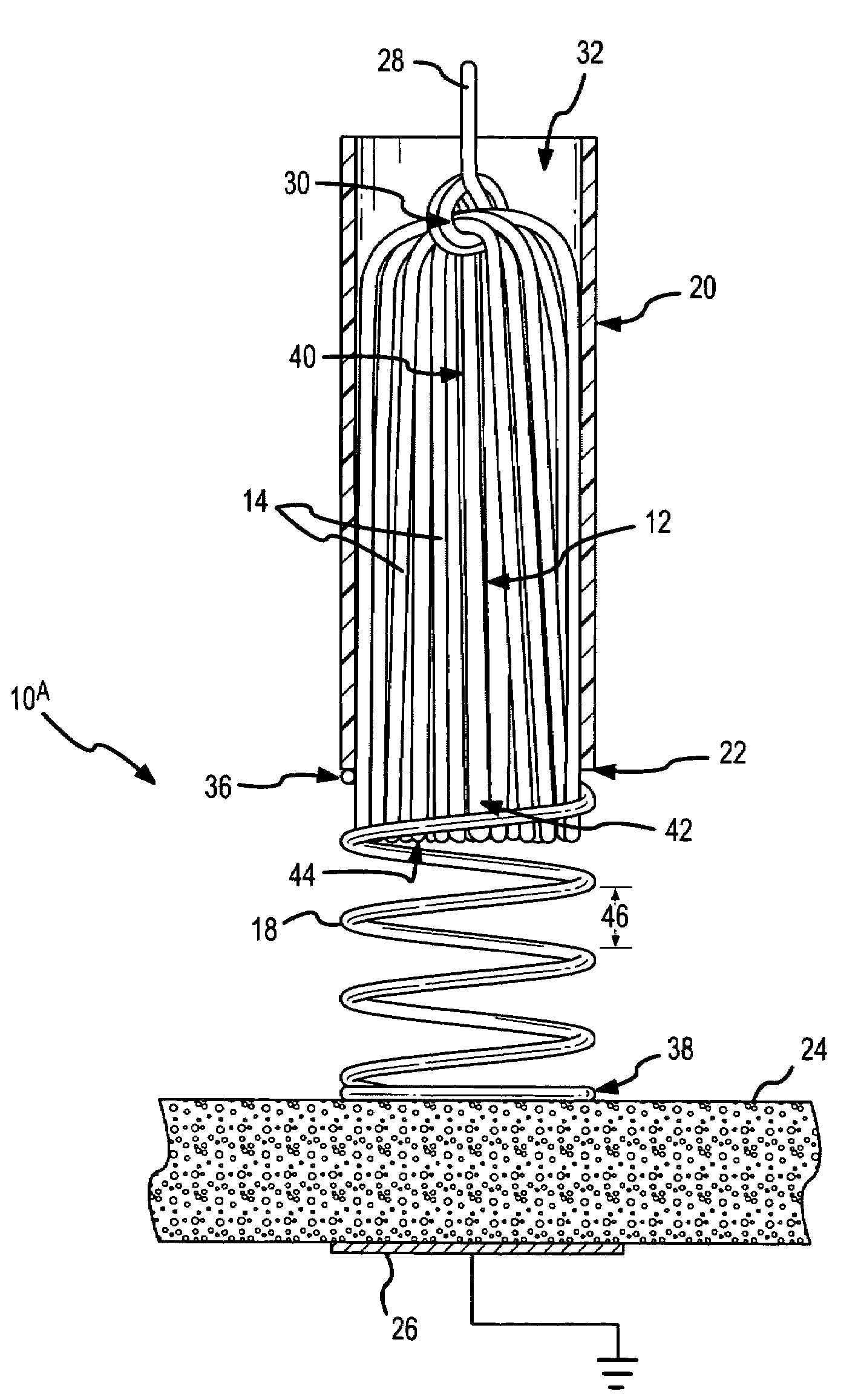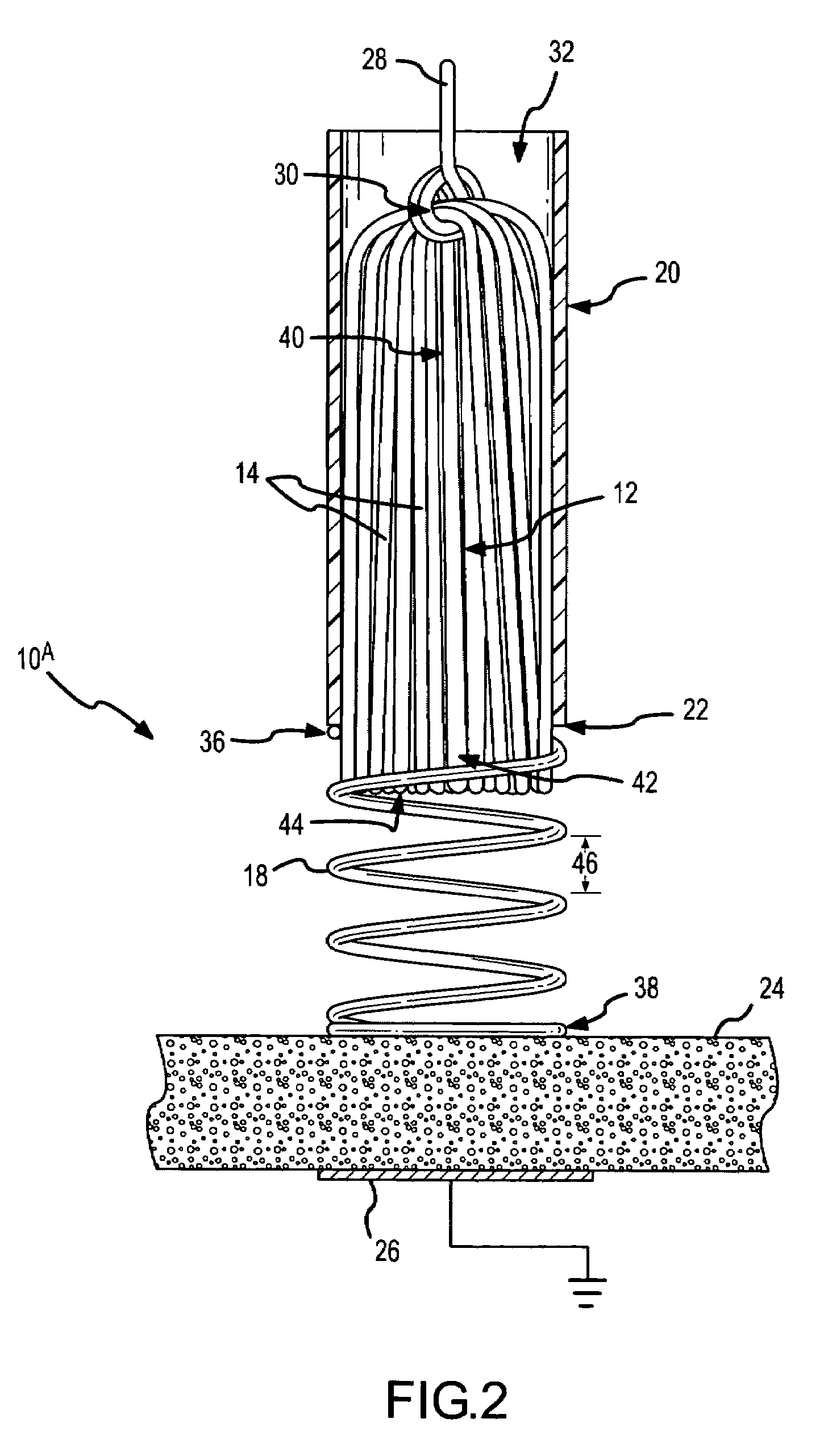Spring-tip, flexible electrode catheter for tissue ablation
a flexible electrode and catheter technology, applied in the field of springtips, can solve the problems of large temperature gradients and hot spots, undesirable coagulum and charring of surface tissue, and may be encountered with a number of difficulties, so as to reduce the amount of conductive fluid, reduce the formation of undesirable coagulum and charring of surface tissue, and mitigate the effect of electrode-tissue contact problems
- Summary
- Abstract
- Description
- Claims
- Application Information
AI Technical Summary
Benefits of technology
Problems solved by technology
Method used
Image
Examples
first embodiment
[0075]In the present invention, the spring-tip, brush electrode catheter 10A comprises a round-wire, coil spring 18 at a distal end 22 of the catheter sheath 20. As clearly shown in FIG. 1, the brush filaments 14 are enshrouded by the round-wire, coil spring 18 that, in this embodiment, extends away from the distal end 22 of the catheter sheath 20. The tissue 24 being ablated is shown schematically, as is a grounding pad or dispersion electrode 26. In the embodiment of FIG. 1, a conductor 28 is looped or noosed around the brush filaments 14 at a connection point 30 inside the catheter lumen 32. In this manner, ablative energy 34 (FIGS. 47-49) is transferred to the flexible electrode 12 (i.e., the brush electrode). Other techniques and structures for transferring the ablative energy from the conductor to the flexible electrode are described in the '919 application, which has been incorporated by reference as though fully set forth herein.
[0076]The round-wire, coil spring 18 has a pro...
fifth embodiment
[0095]FIGS. 16-18 depict the spring-tip, brush electrode catheter 10E according to the present invention. As shown in FIG. 16, which is a fragmentary, isometric view in partial cross section, this embodiment comprises an outwardly-tapering, flat-wire, coil spring 102 at the distal end 22 of the catheter sheath 20. FIG. 17 is a fragmentary view in partial cross section of the spring-tip, brush electrode catheter 10E depicted in FIG. 16 prior to compression of the coil spring 102. FIG. 18 depicts the spring-tip, brush electrode catheter of FIGS. 16 and 17 with the outwardly-tapering, flat-wire, coil spring 102 under compression. As shown to good advantage in this latter figure, when the flat-wire, coil spring 102 is compressed, the coils form an expanding, frustal-conical shield 104 of spring coils around the exposed portion 42 (not visible in FIG. 18) of the brush electrode. Again, the spring-tip, flexible electrode catheter 10E depicted in FIGS. 16-18 may be used to create spot lesi...
seventh embodiment
[0099]FIG. 22 is a fragmentary, isometric view in partial cross section of the spring-tip, brush electrode catheter 10G according to the present invention. In this embodiment, a compressible mesh 112 is present at the distal end 22 of the outer catheter sheath 20. The longitudinal ends or edges of the compressible mesh are contained or embraced by nonconductive or conductive bands. In particular, a distal band 114 is present at one longitudinal edge of the section of compressible mesh 112, and a proximal band 116 is present at the opposite longitudinal edge of the compressible mesh 112.
[0100]FIG. 23 is a fragmentary view in partial cross section of the spring-tip, brush electrode catheter 10G depicted in FIG. 22 with the compressible mesh 112 shown in an uncompressed configuration. As clearly shown in this figure, the compressible mesh 112 comprises overlapping and interwoven strands 118 of conductive or nonconductive material. These flexible, overlapping strands 118 form an “open c...
PUM
 Login to View More
Login to View More Abstract
Description
Claims
Application Information
 Login to View More
Login to View More - R&D
- Intellectual Property
- Life Sciences
- Materials
- Tech Scout
- Unparalleled Data Quality
- Higher Quality Content
- 60% Fewer Hallucinations
Browse by: Latest US Patents, China's latest patents, Technical Efficacy Thesaurus, Application Domain, Technology Topic, Popular Technical Reports.
© 2025 PatSnap. All rights reserved.Legal|Privacy policy|Modern Slavery Act Transparency Statement|Sitemap|About US| Contact US: help@patsnap.com



